2008 CHEVROLET AVALANCHE trailer
[x] Cancel search: trailerPage 349 of 528

Press this button at the end of the shift lever to
enable/disable the Tow/Haul mode.
A light on the instrument
panel will illuminate to
indicate that Tow/Haul
mode has been selected.Your vehicle is equipped with a button at the end of the
shift lever which, when pressed, enables Tow/Haul.
When the button is pressed, a light on the instrument
panel will illuminate to indicate that Tow/Haul has
been selected. Tow/Haul may be turned off by pressing
the button again, at which time the indicator light on
the instrument panel will turn off. The vehicle will
automatically turn off Tow/Haul every time it is started.
Tow/Haul is designed to be most effective when the
vehicle and trailer combined weight is at least 75 percent
of the vehicle’s Gross Combined Weight Rating (GCWR).
See Weight of the Trailer later in this section. Tow/Haul is
most useful under the following driving conditions:
When pulling a heavy trailer or a large or heavy load
through rolling terrain.
When pulling a heavy trailer or a large or heavy load
in stop and go traffic.
When pulling a heavy trailer or a large or heavy load
in busy parking lots where improved low speed
control of the vehicle is desired.
Operating the vehicle in Tow/Haul when lightly loaded
or with no trailer at all will not cause damage. However,
there is no bene�t to the selection of Tow/Haul when
the vehicle is unloaded. Such a selection when unloaded
may result in unpleasant engine and transmission
driving characteristics and reduced fuel economy.
Tow/Haul is recommended only when pulling a heavy
trailer or a large or heavy load.
4-49
Page 350 of 528
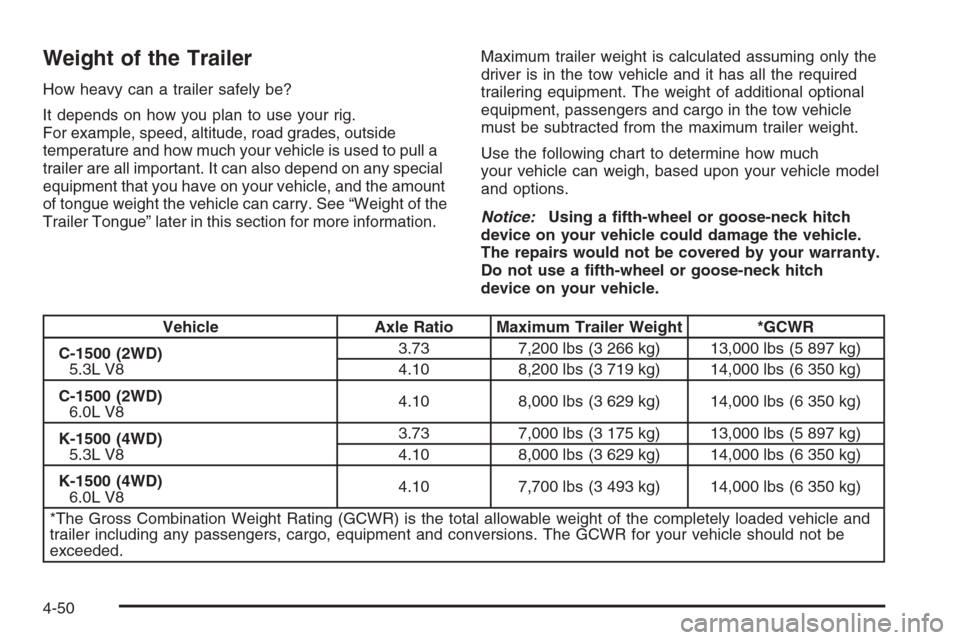
Weight of the Trailer
How heavy can a trailer safely be?
It depends on how you plan to use your rig.
For example, speed, altitude, road grades, outside
temperature and how much your vehicle is used to pull a
trailer are all important. It can also depend on any special
equipment that you have on your vehicle, and the amount
of tongue weight the vehicle can carry. See “Weight of the
Trailer Tongue” later in this section for more information.Maximum trailer weight is calculated assuming only the
driver is in the tow vehicle and it has all the required
trailering equipment. The weight of additional optional
equipment, passengers and cargo in the tow vehicle
must be subtracted from the maximum trailer weight.
Use the following chart to determine how much
your vehicle can weigh, based upon your vehicle model
and options.
Notice:Using a �fth-wheel or goose-neck hitch
device on your vehicle could damage the vehicle.
The repairs would not be covered by your warranty.
Do not use a �fth-wheel or goose-neck hitch
device on your vehicle.
Vehicle Axle Ratio Maximum Trailer Weight *GCWR
C-1500 (2WD)
5.3L V83.73 7,200 lbs (3 266 kg) 13,000 lbs (5 897 kg)
4.10 8,200 lbs (3 719 kg) 14,000 lbs (6 350 kg)
C-1500 (2WD)
6.0L V84.10 8,000 lbs (3 629 kg) 14,000 lbs (6 350 kg)
K-1500 (4WD)
5.3L V83.73 7,000 lbs (3 175 kg) 13,000 lbs (5 897 kg)
4.10 8,000 lbs (3 629 kg) 14,000 lbs (6 350 kg)
K-1500 (4WD)
6.0L V84.10 7,700 lbs (3 493 kg) 14,000 lbs (6 350 kg)
*The Gross Combination Weight Rating (GCWR) is the total allowable weight of the completely loaded vehicle and
trailer including any passengers, cargo, equipment and conversions. The GCWR for your vehicle should not be
exceeded.
4-50
Page 351 of 528
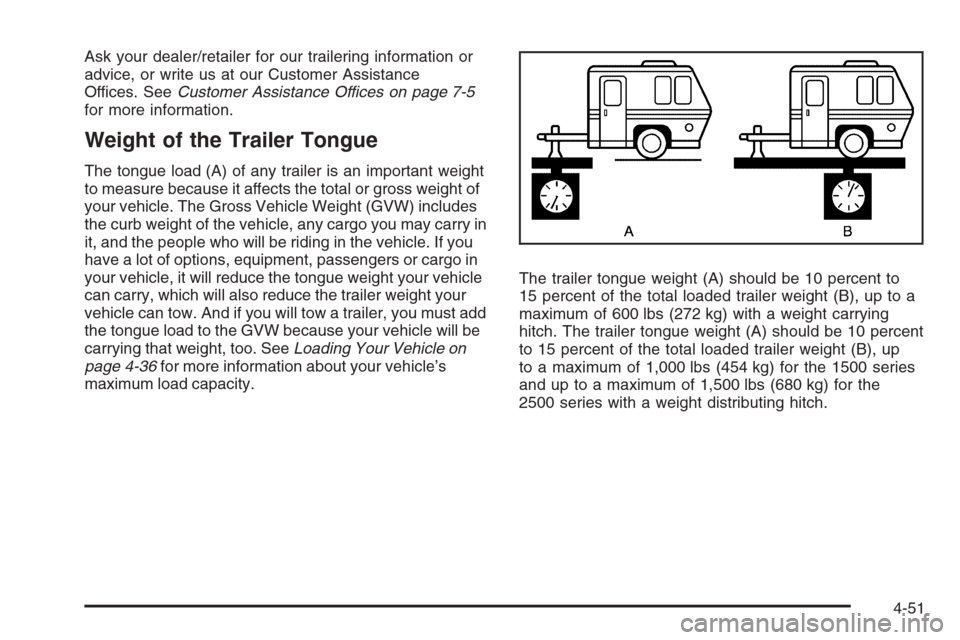
Ask your dealer/retailer for our trailering information or
advice, or write us at our Customer Assistance
Offices. SeeCustomer Assistance Offices on page 7-5
for more information.
Weight of the Trailer Tongue
The tongue load (A) of any trailer is an important weight
to measure because it affects the total or gross weight of
your vehicle. The Gross Vehicle Weight (GVW) includes
the curb weight of the vehicle, any cargo you may carry in
it, and the people who will be riding in the vehicle. If you
have a lot of options, equipment, passengers or cargo in
your vehicle, it will reduce the tongue weight your vehicle
can carry, which will also reduce the trailer weight your
vehicle can tow. And if you will tow a trailer, you must add
the tongue load to the GVW because your vehicle will be
carrying that weight, too. SeeLoading Your Vehicle on
page 4-36for more information about your vehicle’s
maximum load capacity.The trailer tongue weight (A) should be 10 percent to
15 percent of the total loaded trailer weight (B), up to a
maximum of 600 lbs (272 kg) with a weight carrying
hitch. The trailer tongue weight (A) should be 10 percent
to 15 percent of the total loaded trailer weight (B), up
to a maximum of 1,000 lbs (454 kg) for the 1500 series
and up to a maximum of 1,500 lbs (680 kg) for the
2500 series with a weight distributing hitch.
4-51
Page 352 of 528
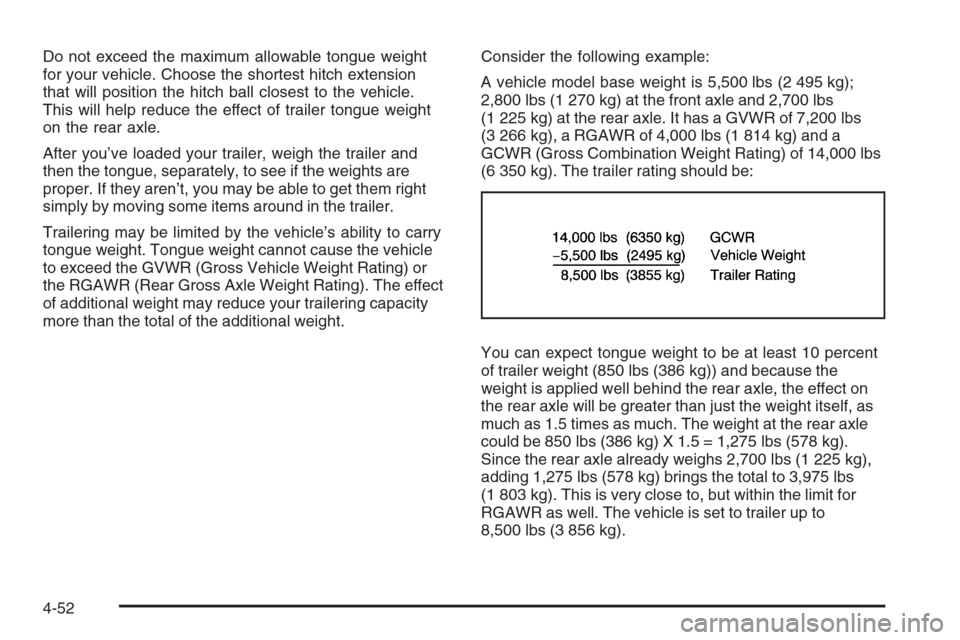
Do not exceed the maximum allowable tongue weight
for your vehicle. Choose the shortest hitch extension
that will position the hitch ball closest to the vehicle.
This will help reduce the effect of trailer tongue weight
on the rear axle.
After you’ve loaded your trailer, weigh the trailer and
then the tongue, separately, to see if the weights are
proper. If they aren’t, you may be able to get them right
simply by moving some items around in the trailer.
Trailering may be limited by the vehicle’s ability to carry
tongue weight. Tongue weight cannot cause the vehicle
to exceed the GVWR (Gross Vehicle Weight Rating) or
the RGAWR (Rear Gross Axle Weight Rating). The effect
of additional weight may reduce your trailering capacity
more than the total of the additional weight.Consider the following example:
A vehicle model base weight is 5,500 lbs (2 495 kg);
2,800 lbs (1 270 kg) at the front axle and 2,700 lbs
(1 225 kg) at the rear axle. It has a GVWR of 7,200 lbs
(3 266 kg), a RGAWR of 4,000 lbs (1 814 kg) and a
GCWR (Gross Combination Weight Rating) of 14,000 lbs
(6 350 kg). The trailer rating should be:
You can expect tongue weight to be at least 10 percent
of trailer weight (850 lbs (386 kg)) and because the
weight is applied well behind the rear axle, the effect on
the rear axle will be greater than just the weight itself, as
much as 1.5 times as much. The weight at the rear axle
could be 850 lbs (386 kg) X 1.5 = 1,275 lbs (578 kg).
Since the rear axle already weighs 2,700 lbs (1 225 kg),
adding 1,275 lbs (578 kg) brings the total to 3,975 lbs
(1 803 kg). This is very close to, but within the limit for
RGAWR as well. The vehicle is set to trailer up to
8,500 lbs (3 856 kg).
4-52
Page 353 of 528

But let’s say your speci�c vehicle is equipped with some
of the latest options and you have a front seat passenger
and two rear seat passengers with some luggage and
gear in the vehicle as well. You may add 300 lbs (136 kg)
to the front axle weight and 400 lbs (181 kg) to the rear
axle weight. Your vehicle now weighs:
Weight is still below 7,200 lbs (3 266 kg) and you may
think that you should subtract 700 additional pounds
(318 kg) from your trailering capacity to stay within
GCWR limits. Your maximum trailer would only
be 7,800 lbs (3 538 kg). You may go further and think
you must limit tongue weight to less than 1,000 lbs
(454 kg) to avoid exceeding GVWR. But, you must
still consider the effect on the rear axle. Because your
rear axle now weighs 3,100 lbs (1 406 kg), you can only
put 900 lbs (408 kg) on the rear axle without exceeding
RGAWR. The effect of tongue weight is about 1.5
times the actual weight. Dividing the 900 lbs (408 kg) by1.5 leaves you with being able to handle only 600 lbs
(272 kg) of tongue weight. Since tongue weight is
usually at least 10 percent of total loaded trailer weight,
you can expect that the largest trailer your vehicle
can properly handle is 6,000 lbs (2 721 kg).
It is important that you make sure your vehicle does not
exceed any of its ratings — GCWR, GVWR, RGAWR,
Maximum Trailer Rating or Tongue Weight. The only way
to be sure you are not exceeding any of these ratings is to
weigh your vehicle and trailer.
Total Weight on Your Vehicle’s Tires
Be sure your vehicle’s tires are in�ated to the upper
limit for cold tires. You’ll �nd these numbers on
the Certi�cation label at the rear edge of the driver’s
door or seeTires on page 5-56. Then be sure you don’t
go over the GVW and rear axle limits for your vehicle,
including the weight of the trailer tongue.
If you use a weight distributing hitch, make sure you
don’t go over the rear axle limit before you apply
the weight distributing spring bars.
Hitches
It’s important to have the correct hitch equipment.
Crosswinds, large trucks going by and rough roads are
a few reasons why you’ll need the right hitch.
4-53
Page 354 of 528
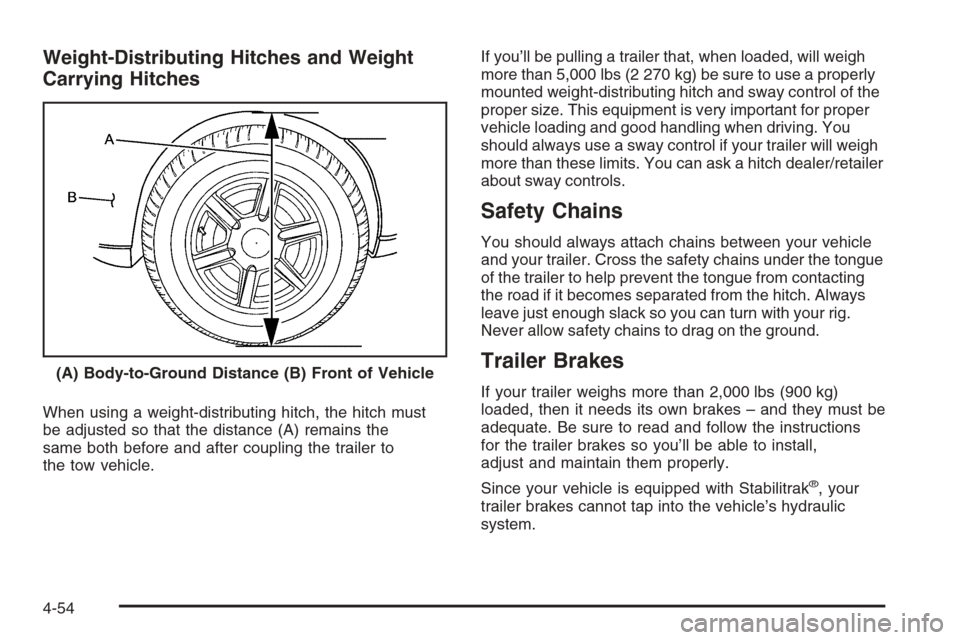
Weight-Distributing Hitches and Weight
Carrying Hitches
When using a weight-distributing hitch, the hitch must
be adjusted so that the distance (A) remains the
same both before and after coupling the trailer to
the tow vehicle.If you’ll be pulling a trailer that, when loaded, will weigh
more than 5,000 lbs (2 270 kg) be sure to use a properly
mounted weight-distributing hitch and sway control of the
proper size. This equipment is very important for proper
vehicle loading and good handling when driving. You
should always use a sway control if your trailer will weigh
more than these limits. You can ask a hitch dealer/retailer
about sway controls.
Safety Chains
You should always attach chains between your vehicle
and your trailer. Cross the safety chains under the tongue
of the trailer to help prevent the tongue from contacting
the road if it becomes separated from the hitch. Always
leave just enough slack so you can turn with your rig.
Never allow safety chains to drag on the ground.
Trailer Brakes
If your trailer weighs more than 2,000 lbs (900 kg)
loaded, then it needs its own brakes – and they must be
adequate. Be sure to read and follow the instructions
for the trailer brakes so you’ll be able to install,
adjust and maintain them properly.
Since your vehicle is equipped with Stabilitrak
®, your
trailer brakes cannot tap into the vehicle’s hydraulic
system. (A) Body-to-Ground Distance (B) Front of Vehicle
4-54
Page 355 of 528
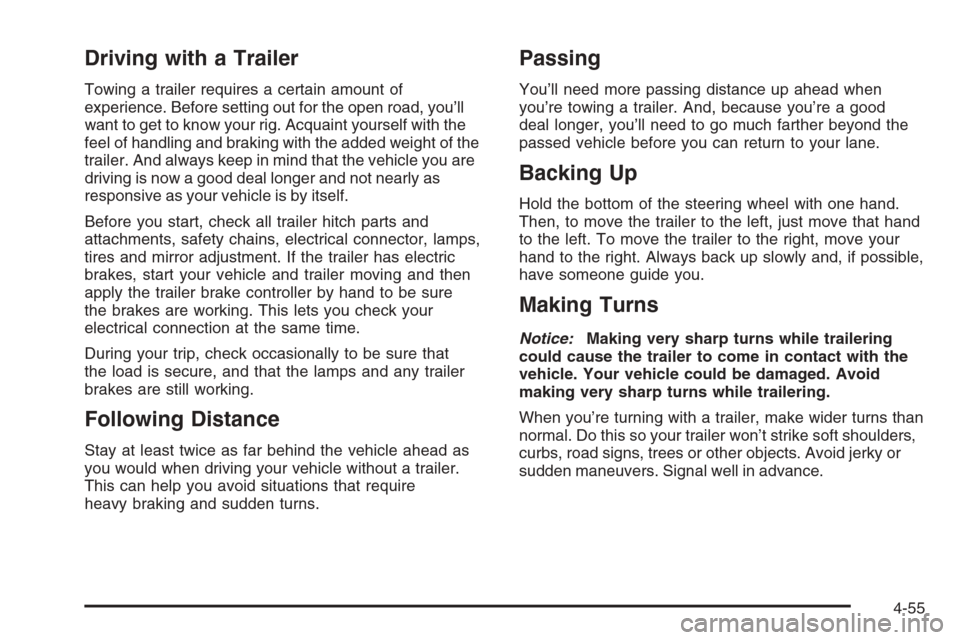
Driving with a Trailer
Towing a trailer requires a certain amount of
experience. Before setting out for the open road, you’ll
want to get to know your rig. Acquaint yourself with the
feel of handling and braking with the added weight of the
trailer. And always keep in mind that the vehicle you are
driving is now a good deal longer and not nearly as
responsive as your vehicle is by itself.
Before you start, check all trailer hitch parts and
attachments, safety chains, electrical connector, lamps,
tires and mirror adjustment. If the trailer has electric
brakes, start your vehicle and trailer moving and then
apply the trailer brake controller by hand to be sure
the brakes are working. This lets you check your
electrical connection at the same time.
During your trip, check occasionally to be sure that
the load is secure, and that the lamps and any trailer
brakes are still working.
Following Distance
Stay at least twice as far behind the vehicle ahead as
you would when driving your vehicle without a trailer.
This can help you avoid situations that require
heavy braking and sudden turns.
Passing
You’ll need more passing distance up ahead when
you’re towing a trailer. And, because you’re a good
deal longer, you’ll need to go much farther beyond the
passed vehicle before you can return to your lane.
Backing Up
Hold the bottom of the steering wheel with one hand.
Then, to move the trailer to the left, just move that hand
to the left. To move the trailer to the right, move your
hand to the right. Always back up slowly and, if possible,
have someone guide you.
Making Turns
Notice:Making very sharp turns while trailering
could cause the trailer to come in contact with the
vehicle. Your vehicle could be damaged. Avoid
making very sharp turns while trailering.
When you’re turning with a trailer, make wider turns than
normal. Do this so your trailer won’t strike soft shoulders,
curbs, road signs, trees or other objects. Avoid jerky or
sudden maneuvers. Signal well in advance.
4-55
Page 356 of 528

Turn Signals When Towing a Trailer
The arrows on your instrument panel will �ash whenever
you signal a turn or lane change. Properly hooked up,
the trailer lamps will also �ash, telling other drivers
you’re about to turn, change lanes or stop.
When towing a trailer, the arrows on your instrument
panel will �ash for turns even if the bulbs on the trailer
are burned out. Thus, you may think drivers behind
you are seeing your signal when they are not. It’s
important to check occasionally to be sure the trailer
bulbs are still working.
Driving On Grades
Reduce speed and shift to a lower gearbeforeyou start
down a long or steep downgrade. If you don’t shift
down, you might have to use your brakes so much
that they would get hot and no longer work well.You can tow in DRIVE (D). If the transmission shifts too
often (e.g., under heavy loads and/or hilly conditions)
you may want to shift the transmission to a lower
gear selection or enable the Tow/Haul mode.
See “Tow/Haul Mode” earlier in this section.
When towing at high altitude on steep uphill grades,
consider the following: Engine coolant at higher altitudes
will boil at a lower temperature than at or near sea level.
If you turn your engine off immediately after towing at
high altitude on steep uphill grades, your vehicle may
show signs similar to engine overheating. To avoid this,
let the engine run while parked (preferably on level
ground) with the automatic transmission in PARK (P) for
a few minutes before turning the engine off. If you do
get the overheat warning, seeEngine Overheating on
page 5-28.
4-56